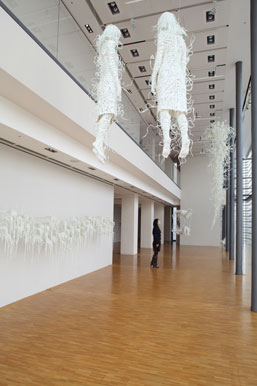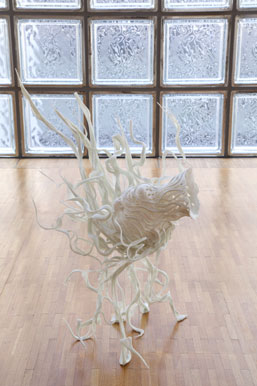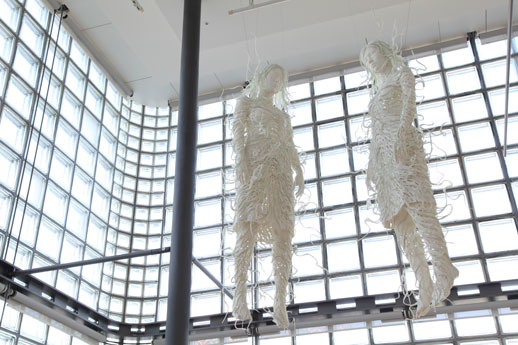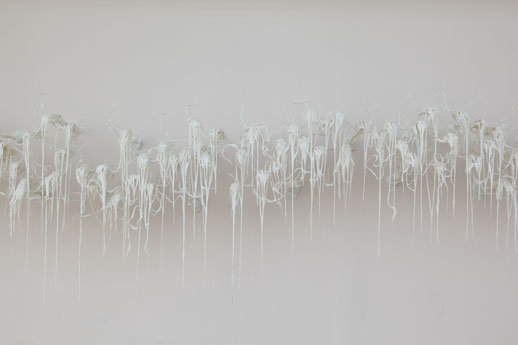Angels and Demons in Ginza
The body, in the wrong hands, can be ugly. I blame the twentieth century; before then, it seems the body was only something physical, a form to be perfected by the pen. The ancients biblicized it, the romantics idealized it and Rembrandt and his followers humanized it; but it remained, generally, an object. It was only around a hundred years ago that the psychological, emotional and biological dimensions of the body were not only discernible from the subject’s expression, but were also incorporated directly into the artwork. The body itself became a vehicle through which the artist could communicate mood, tension, atmosphere, social or political meanings, and more. More recently, the bionic capabilities of the body and the merging of it with machines has become a popular experiment for artists.
But for all the thought-provoking and intensely beautiful art this shift may have produced, it is also culpable for the slew of amateurs churning out overly emotive, crudely rendered pieces of cheesy tat. Remember the school art room? More blood, tears and screaming faces than an emergency room — and that was just the canvases. The kids seem to take one look at Francis Bacon, Munch, Richard Long — to name but a few — and think that body + visible anguish = profundity. This retarded equation perhaps explains why they were studying art and not algebra.
To me, art that mixed emotion with the body always seemed to tiptoe a very thin line between affecting and awful — which is why I was slightly apprehensive when I read the bombastic blurb for Motohiko Odani’s new exhibition: “he strives to express the dynamism of the body by capturing…moments of pain or transformation… sculpting the human body of a different dimension.” Gosh. It also claims that the works will “disorientate the viewer’s sense of gravity.” (Quite perturbing, I should think, in a city vulnerable to earthquakes). Such exaggerated claims suggested an ambitious amateur (the worst sort) — but I put my school day demons to rest and put my faith in Maison Hermès, whose curatorial skills and architectural setting impressed me so much with Kohei Nawa’s most recent exhibition.


The gorgeous, glacial background of glass tiles works as well for Odani’s work as it did for Nawa’s, perhaps because they share the same stark white mono-palette. This signals a break for Odani from his previous work, which was a mixture of photography (“Phantom Limb”), and sculpture, neither of which avoided colour. Perhaps he was in some way influenced by Nawa, since they now have a theme in common; the fusion of organic, biological processes and artificial materials. Both take on the traditional challenge of sculpture; to inject life and dynamism into static materials.
The first pieces I see embrace this traditionalism in their Latinate names: ‘Newborn (capybara B)’ and ‘Newborn (tuatara Z)’. They are rippling spirals of fused vertebrae, bringing to mind both primordial foetuses and terrifying tooth-spawning tumours. The next room revisits ancient myths, with a gigantic head and hand rising out of the ground, cut off at the neck and wrist. Spindly white strings emit from both, stretching out like solidified streams of breath or blood. The shawled female head, looking for all the world like the holy Mary drawing her last breath, is awesome in its scale, making the viewer feel somewhat Lilleputian.

The main room reveals the white spindly lines to be a motif; they twist around two suspended bodies in ‘Reversal Cradle’, wrap around hair in ‘Braid’, and form an almighty column, like a fizzling, crackling neuron, in ‘Floating Thinker’. With many of the blank, still bodies resembling Pompeian statues, Odani delves further into Grecian mythology with ‘Hollow; Hydra’s head’, a bust of the snake goddess whose face is ghoulishly constructed of overlapping fibres, bereft of flesh and mad-eyed.
There is a curious mix of aesthetic underneath the uniform technique, however. Along with the romantic Roman and Greek elements of flowing hair and porcelain flesh, the skeletal sculptures remind me of sci-fi flicks, while the suspended bodies hint at some kind of futuristic bionic human forms. One of the most visually impressive pieces is ‘Hollow; Pianist/Rondo’, a vast wall of hands dripping the same white strands. While ethereal and elegant, it does somehow recall the zombies’ hands in Michael Jackson’s Thriller, clawing out from the ground.
That all of these incongruous elements gel is down to their execution; both literally and metaphorically glossed over by smooth white paint. Noi Sawaragi, who supervised Odani’s previous exhibition, “Phantom Limb,” suggests that the artist partly achieves this synthesis of influences because of his age and nationality. He noted that as Odani was one of the first major Japanese artists to have worked entirely through the age of the ‘superflat’, a much-trumped idea conceptualised by Takashi Murakami. He saw modern Japanese art as ‘superflat,’ in that it playfully disregards historical context and preconceived meanings by collapsing genres into a singular, ‘flat’ aesthetic. It is true that Japanese artists, so distanced from the Western canon and forced to digest it in one go, often seem to rifle through it with the giddy disregard of children in a dressing up box. This is not a bad thing, however; in some ways they are freed from the restrictive tyranny of Western art, in which a certain reverence for chronology, context and nuance is expected. Odani manages to compress so much into his work because of his attention to execution and visual impact — largely sidestepping the amateurish touches I bemoaned above. A couple of the pieces, like ‘Hollow; Duplex’, are tinged with a slightly teenage obsession with angels and myths, but not enough to sully their beauty.

Respect must also be paid to Maison Hermès, which is fast becoming one of my favourite galleries; mid-sized and blessed with a modern versions of stained glass windows, it complements the otherworldly aspect of Odani’s work. In his mission statement he claims that he tries to make real that which can only be imagined; and while he might not achieve the dizzy ambition of the gallery’s blurb, he certainly creates an imaginary world of considerable visual impact.
Sophie Knight
Sophie Knight



